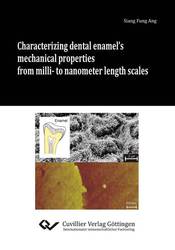| Departments | |
|---|---|
| Book Series (96) |
1378
|
| Nachhaltigkeit |
3
|
| Gesundheitswesen |
1
|
| Humanities |
2364
|
| Natural Sciences |
5406
|
| Engineering |
1793
|
| Engineering | 292 |
| Mechanical and process engineering | 862 |
| Electrical engineering | 686 |
| Mining and metallurgy | 30 |
| Architecture and civil engineering | 75 |
| Common |
98
|
|
Leitlinien Unfallchirurgie
5. Auflage bestellen |
|
Advanced Search
Characterizing dental enamel’s mechanical properties from milli- to nanometer length scales (English shop)
Siang Fung Ang (Author)Preview
Extract, PDF (470 KB)
Table of Contents, PDF (53 KB)
Understanding the structure-property relationship of enamel is a basis to improve restorative and preventive dentistry. The structure-mechanical properties relationship of dental enamel (made of apatite fibers and a small amount of organics and water) was studied. Enamel’s elastic moduli, elastic/inelastic transition were quantified and the toughening mechanisms were identified for different hierarchical levels. During creep, the interrod regions are able to dissipate higher irreversible energy compared to the enamel rod regions. For enamel fracture, the crack tip toughness, the cohesive stresses and size of the cohesive zone at the crack-tip were quantified.
| ISBN-13 (Hard Copy) | 9783954041657 |
| ISBN-13 (eBook) | 9783736941656 |
| Final Book Format | A5 |
| Language | English |
| Page Number | 130 |
| Lamination of Cover | glossy |
| Edition | 1. Aufl. |
| Publication Place | Göttingen |
| Place of Dissertation | Hamburg-Harburg |
| Publication Date | 2012-07-24 |
| General Categorization | Dissertation |
| Departments |
Engineering
|
| Keywords | enamel, hydroxyapatite; compression; nanoindentation; fracture; toughness; elastic/inelastic transition; energy; creep; viscoelasticity; mechanical properties. |








